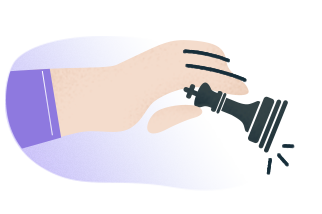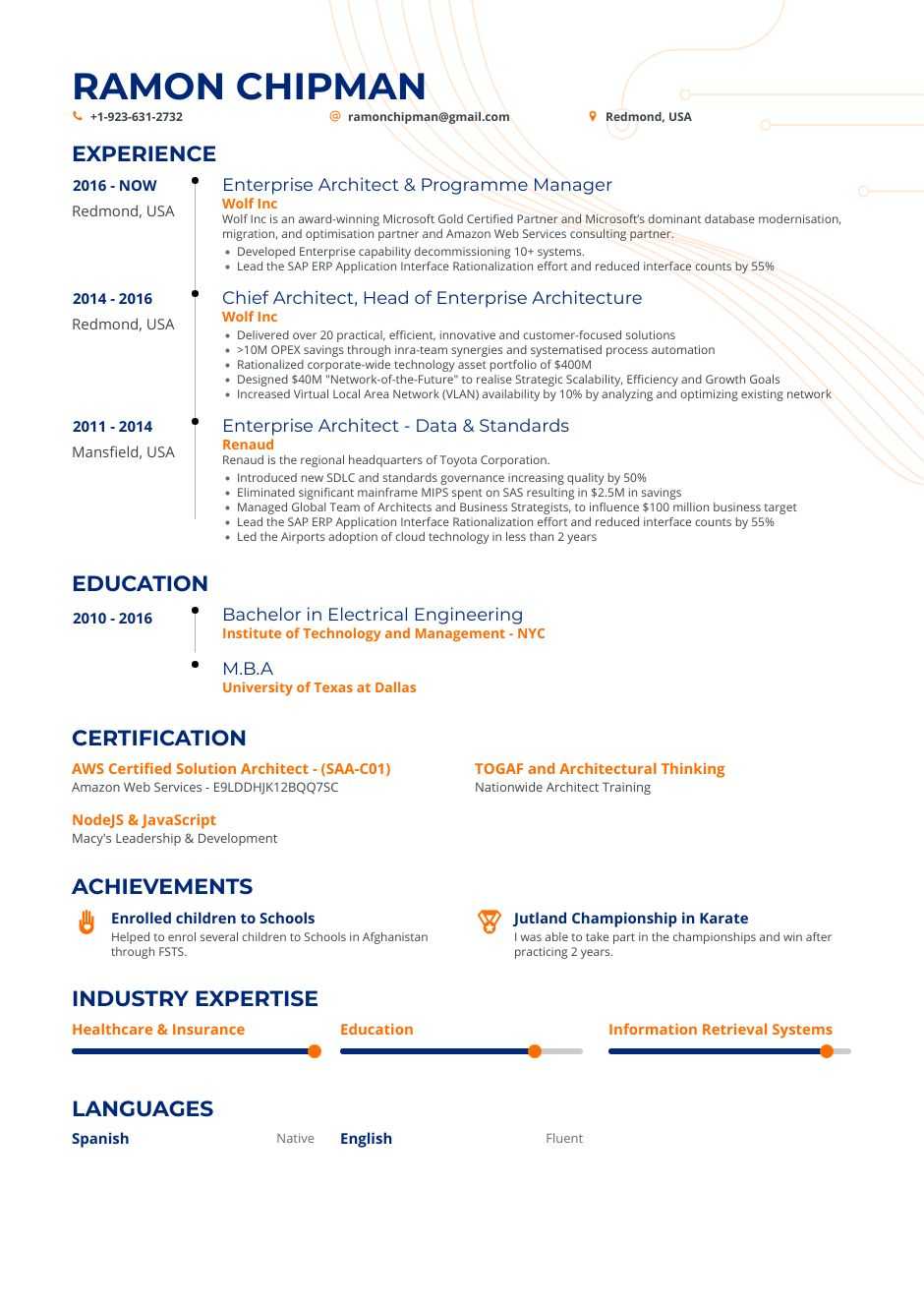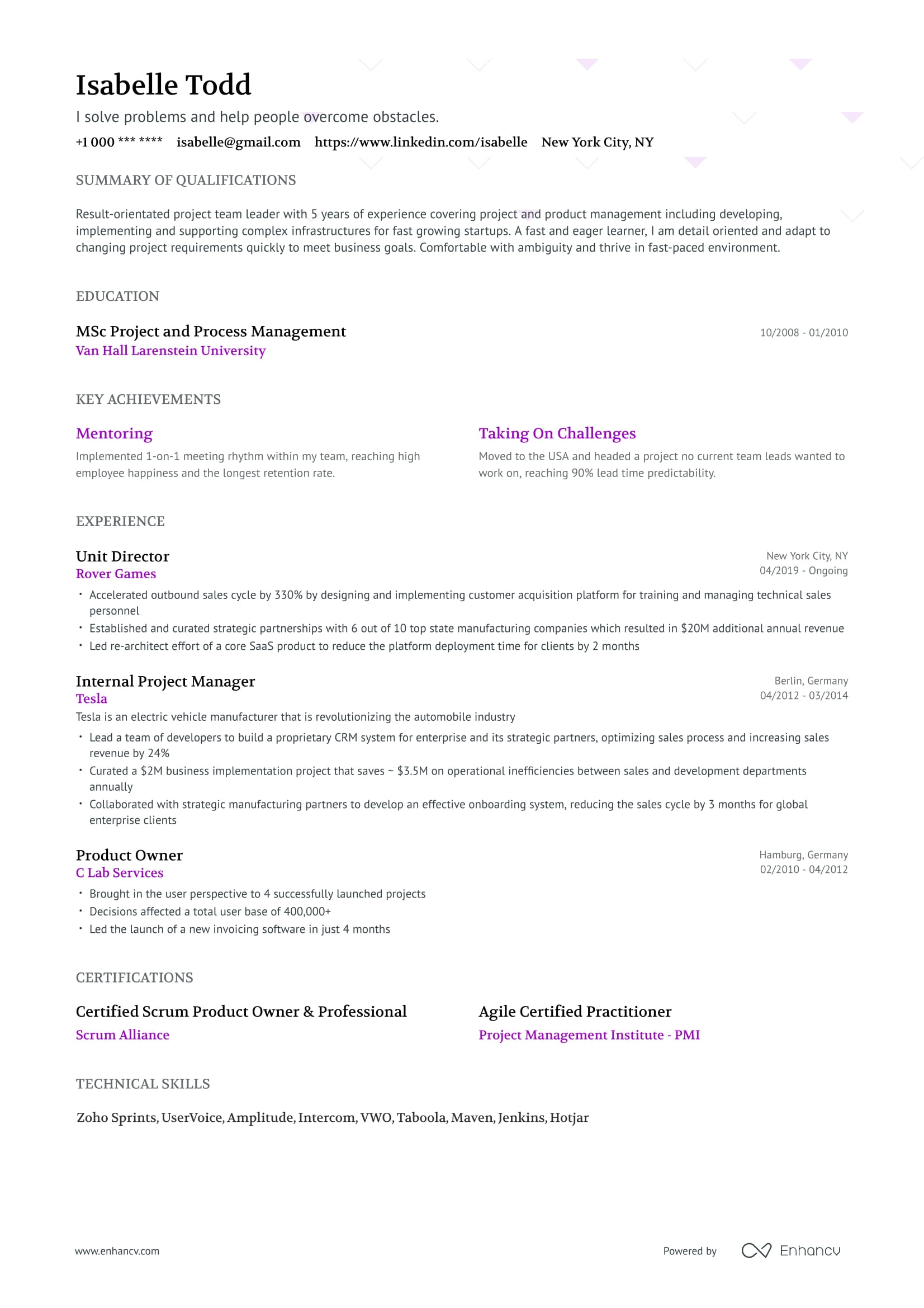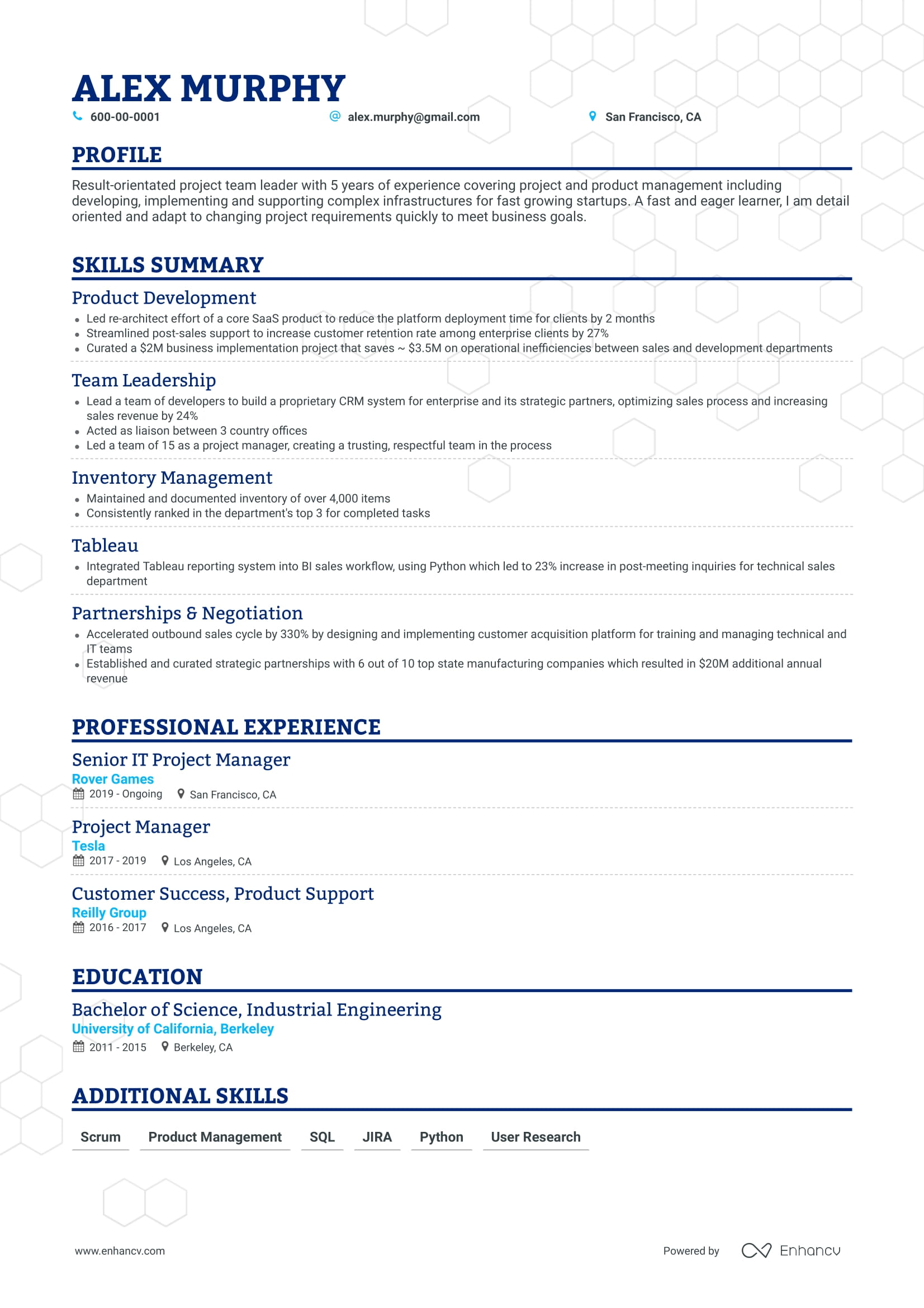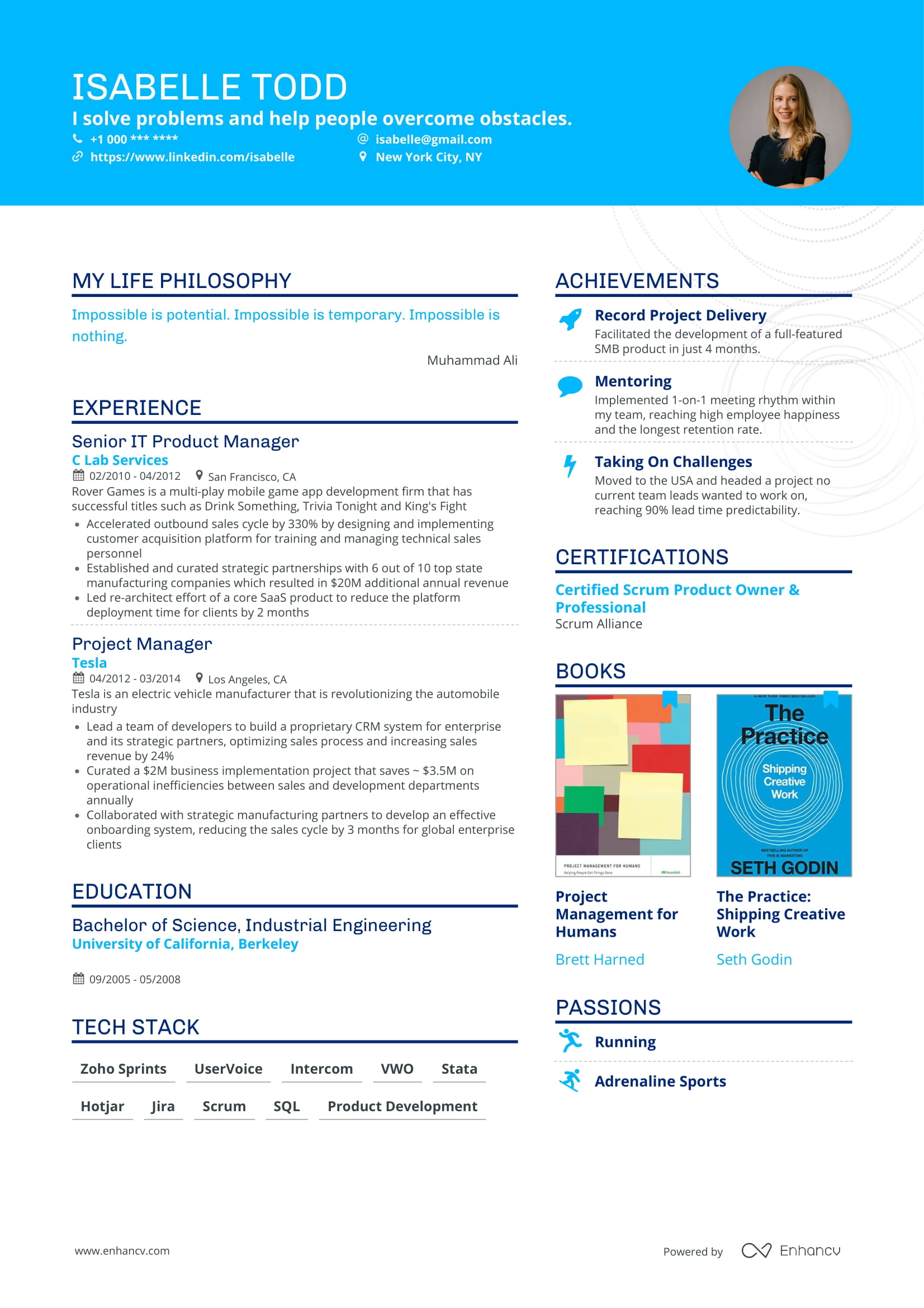Example Enterprise Architect Resume - Browse more resume templates and build a stand-out resume
Do you know what every company on this planet has? An enterprise architecture. Do you know what most companies don't have? An Enterprise Architect.
Why? Because it’s darn hard to find a good Enterprise Architect that is worth their money.
Many people claim to be Enterprise Architects but at the end of the day act as a glorified helpdesk for the CEO.
You want your Enterprise Architect resume to tell a different story.
In this Enterprise Architect Resume guide you will learn
✔ Real examples from Enterprise Architect resumes that got people hired
✔ How to balance business and technical experience on your Enterprise Architect resume to land more job interviews
✔ How to include your value proposition in your background in order to be noticed by recruiters
✔ What skills are essential to landing a job as an Enterprise Architect
✔ How to properly structure your resume for senior and entry Enterprise Architect positions
Enterprise Architect resume samples
Looking for related resumes? We got you covered
How to write an Enterprise Architect resume
Being an Enterprise Architect is a complicated job.
EAs have to thoroughly know both technical aspects of their company (IT infrastructure, applications, technical staff) and its business aspects.
More importantly, an EA has to know how the former serves the latter in the best way.
The balance between these two domains is crucial: lean a bit too far into technical direction and you’re a Solutions Architect. Lean too much into the business side, and you’re just another manager.
Your resume should do exactly the same: demonstrate both business acumen and technical intelligence in order to even be considered as a potential candidate.
Even more, certain positions will require proficiency in security, privacy, accessibility domains as well.
Everything - the summary, the experience, and skills sections should reflect your qualification.
Let us help you by providing specific examples for each of these sections.
Don’t miss out on these 5 Enterprise Architect resume sections
- Professional summary
- Header with contact details & links to your online presence
- Experience section with your top achievements
- Soft and hard skills section
- Education & certificates
For more information on the best resume format options, read our guide:The Best Resume Formats You Need to Consider (5+ Examples Included).
Enterprise Architect summary: how to make it great
It’s said that EAs look both ways: at the present and into the future. That is because every enterprise architecture has two states: current and potential.
EAs can’t afford to look exclusively into how things work now. Their job is also to facilitate improvement and oversee it.
Don’t let your summary look like you're a maintenance agent.
Another example of a so-so summary is when you focus exclusively on technical achievements rather than business achievements.
No worries, you’ll have the experience and skills section to highlight your technical expertise. For now, use the summary space more strategically.
The thing is, in the ’90s the common approach was to prioritize IT infrastructure and then build business operations on top of it.
However, since the 2000’s there was a complete shift of priorities and now IT serves as a facilitator for business agenda. Make sure your resume summary reflects that.
Also, don’t simply provide a detailed assessment of the present architecture. Demonstrate how you improved it. It is highly recommended to reflect the results of your work in business numbers (scale, profit, budget, etc.)
To avoid your resume coming off as irrelevant, you should prioritize business value in your summary section over specific technical expertise.
For more tips on crafting an attention-grabbing resume summary, check out our guideResume Summary: How-To Guide (30+ Examples You Need To See).
However, you can’t be an Enterprise Architect without deep knowledge of IT systems. That is why your experience section should combine both technical and business experience.
Let us provide specific examples in the next section.
Enterprise Architect resume: how to structure your experience
We’ve already talked about the importance of balancing technical and business skills in every section of your Enterprise Architect resume.
However, the experience section offers you a unique chance to showcase both and even more.
Given the strategic position of the Enterprise Architect in a company, there are some skills that are particularly valuable for businesses:
- Domain expertise
- IT Trends awareness
- Panoramic perspective
Domain expertise is paramount. Most companies even highlight it in their own job descriptions:
5-7 years’ experience in either an Enterprise Architecture, IT Technical Architect, Senior IT Engineering, or equivalent experience in a major domain area for applications, technology, and IT security
Other companies may be looking for EAs with specific knowledge of IT security, government regulations, sales or even skills as specific as those needed for IT mergers.
Those requirements are always visible and tend to pop up among the usual “lead our IT”.
Trend awareness is another thing most companies look for in their potential candidates. It involves your ability to recognize specific IT trends, follow and utilize them.
In a job description, those requirements may look like these:
In-depth knowledge of and proven cloud experience with Microsoft Azure data management and business intelligence stack including Azure Data Factory, Azure Data Lake (Gen 2), Databricks, Azure Analysis Services, Azure SQL Database, and Power BI
Finally, a panoramic perspective. You are not an IT guy, you’re an IT chief. You always have a birdeye’s view of the organization, so channel your experience in the same manner.
There is a position closely related to Enterprise Architect, an Enterprise Data Architect. It focuses on a specific part of the enterprise framework: Data.
To understand the difference, we will look at one of the most popular frameworks that describe enterprises: TOGAF (The Open Group Architecture Framework).
According to TOGAF, there are 4 architecture domains in every enterprise:
- Business architecture
- Data architecture
- Applications architecture
- Technical architecture
The key difference between these two positions is the scope of operation.
While the Enterprise Architect strategically governs operations at the intersection of all 4 domains of organization, an Enterprise Data Architect primarily focuses on Data domain and its connections with the others.
That’s why, if you’re applying for an Enterprise Data Architect position, focus on your key competence within Data domain, otherwise your resume will look off.
See? Your resume would look like you’re applying to be an Enterprise Architect. This is how it should look.
Finally, let’s talk about a Chief Enterprise Architect resume. This position requires a vast amount of experience and usually exists only with established, mature enterprises.
The maturity of enterprise architecture in organizations can be described with a Gartner’sITScore maturity assessment:
Level 1: Nonexistent
Level 2: Reactive
Level 3: Functioning
Level 4: Integrated
Level 5: Ubiquitous
On levels 1,2,3, the primary goal of Enterprise Architects is to mostly provide guidance to the business in terms of IT and giving IT-operations more structure.
On levels 4 & 5, Enterprise Architects utilize IT to its fullest potential for the benefit of the business, constantly improving and prospecting for new benefits.
This is where the Chief Enterprise Architect will mostly operate: bringing the transformation to how businesses gain value from IT assets to their fullest potential.
A typical resume of a Chief Enterprise Architect stands out because of the overall EA experience and business-oriented global achievements.
For more ideas on how to create an actionable resume experience section, check out our guideHow to Describe Your Resume Work Experience.
With your experience set up, let’s finish with the skills section of your resume.
Enterprise Architect technical & soft skills to include on a resume
Soft skills are the bread and butter for Enterprise Architects as much as technical skills.
Apart from strategic thinking and leadership, the EA often has to develop educational programs for all departments that are part of the IT enterprise transformation.
EAs are also agents of change, so conflict resolution and negotiation skills are an integral part of their workflow.
Don’t simply feature your soft skills on your resume. Provide examples of situations where they helped you resolve an argument, or prove a point in front of your business leaders.
12 Soft skills to include on an Enterprise Architect resume
- Communication
- Leadership / Governance
- Analytical Thinking
- Strategic Thinking
- Researching skills
- Assertiveness
- Conflict resolution
- Negotiation
- Flexibility
- Teaching (Sharing Knowledge)
- Risk Management
- Legal (Commercial, Contract, Data Protection Laws)
The technical skills required vary for different organizations. Here’s a list of the most popular skills best to have in your resume.
16 Technical skills to reflect your EA expertise
- General IT Knowledge Skills (SLAs, asset management, QA & data, VC apps)
- Business Analysis (Scope, Gap Analysis, Use Cases, etc.)
- Software Engineering Practices
- SQL (especially for Enterprise Data Architects)
- Cloud
- Visio, Office
- MS Office
- Agile Development Practices
- IT Security
- Network Management & Services
- ERP / Salesforce
- Microsoft Server Infrastructure
- Digital & Mobile Technologies (iOS, Android)
- CI/CD Pipeline (Chef, Puppet, AWS, Jenkins, Git)
- AI / Machine Learning
- ITILv3, CMMI, SDLC methodologies knowledge
Are you still not sure what skills will win recruiters over? Check out our guide onHow to Create A Resume Skills Section To Impress Recruiters (+10 Examples You Need to See).
Finally, let’s talk about if you can mention any certificates when applying for an EA position.
Enterprise Architect resume: most relevant certifications
There are not that many certificates specifically for Enterprise Architects, yet some are very useful in their work and hiring process.
TOGAF: is the development and architecture framework of choice for about 80% of global enterprises. It offers two certification levels:
Level 1: TOGAF 9 Foundation
Level 2: TOGAF Certified
Every EA should be capable of acquiring a Level 2 TOGAF certification. Obtaining this certificate, without doubt, adds legitimacy to your overall EA portfolio.
Honorable mentions: Open CA (Certified Architect), Zachman International Enterprise Architect, ITAC.
If you’re looking for boosting your technology expertise and legitimacy, consider ITIL (IT Service), Network Security (Cisco), Cloud (AWS), domain (PRINCE2 ) and Microsoft (MCA) certifications.
When it comes to education, MBA is a valuable degree that confirms an EA’s business focus.
Apart from this, most EA positions require a degree in Computer Science, Network or related IT domain.
However, there are positions that can drop the relevant education requirement in case of significant relevant experience.
For more information on how to properly list resume certifications, we recommend reading our guideHow To List Certifications On A Resume (Examples Included).
Browse more essential tips on how to feature education on your resume, in our guidePerfecting the Education Section on Your Resume.
Other sections to include on your resume
Depending on the company, job seniority level and your location, you may want to include more sections to your Enterprise Architect resume:
Enterprise Architect resume: takeaways and most effective advice
- Keep the balance between technology and business acumen in your portfolio with a strong focus on bringing business value
- Make sure you emphasize your skills not only in the “skills” section but in the experience section as well
- Frame your experience from the very first sentence to give off a “Strategist” vibe rather than “Specialist” vibe
- Recruiters perceive Enterprise Architect and Enterprise Data Architect resume completely differently, so focus your resume on the position you’re applying for
- Make sure to include relevant certificates in your resume and drop outdated technology skills so you don’t come off as a “legacy manager”
